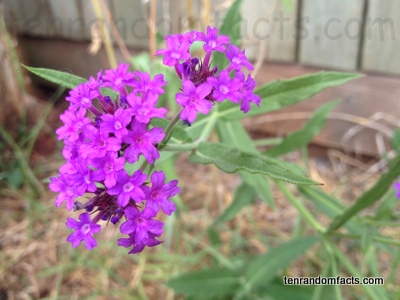Slender vervain: a pest in some places, an ornament in others.
- A ‘slender vervain’ is also known as a ‘tuberous vervain’, ‘purpletop’, ‘purple verbena’, ‘veined verbena’, ‘large-veined verbena’, ‘sandpaper verbena’, and it also has many other common names.
- Slender vervains are native to many countries in South America, and more specifically Brazil and Argentina.
- Slender vervains can grow up to 60 centimetres (24 inches) in height.
- The scientific name for slender vervain is ‘Verbena rigida’, and it has also been known as ‘Verbena venosa’, and it comes from the family Verbenaceae, the family of vervains or verbenas.
- Slender vervains have purple or magenta coloured flowers that bloom on the top of spikes at the top of the plant in summer and autumn, and the plants have rigid, rough and hairy leaves that have serrated edges.
- In 1993, Slender vervains were awarded the United Kingdom Royal Horticultural Society Award of Garden Merit.
- Slender vervains are best grown in areas with full sun and damp, well drained soil, and are often grown to add colour in the garden, in pots, or for cut flowers.
- Slender vervains grow from rhizomes, and are herbacious perennials with parts of the plants dying off each year.
- Slender vervains are classified as a weed in South Africa, Australia and some parts of the United States, and are found near roads, inhabiting forests, fields and river areas, as well as cotton farming land.
- Slender vervains were introduced into Europe by Dr John Gillies, a Scottish botanist and retired navy surgeon, in approximately 1820.
Bibliography:
Bourne V, How to Grow: Verbena Rigidia, 2013, The Telegraph, http://www.telegraph.co.uk/gardening/howtogrow/3348813/How-to-grow-Verbena-rigida.html
Verbena Rigidia (Herb), 2010, Global Invasive Species Database, http://www.issg.org/database/species/ecology.asp?fr=1&sts=&lang=EN&si=1371
Verbena Rigida, 2013, Wikipedia, http://en.wikipedia.org/wiki/Verbena_rigida







